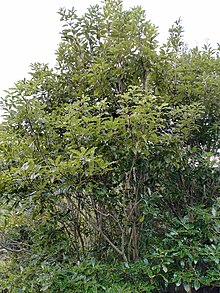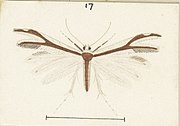| Pterophorus furcatalis | |
|---|---|

| |
| Scientific classification | |
| Domain: | Eukaryota |
| Kingdom: | Animalia |
| Phylum: | Arthropoda |
| Class: | Insecta |
| Order: | Lepidoptera |
| Family: | Pterophoridae |
| Genus: | Pterophorus |
| Species: | P. furcatalis |
| Binomial name | |
| Pterophorus furcatalis (Walker, 1864) | |
| Synonyms | |
| |
Pterophorus furcatalis, the Pittosporum plume moth, is a moth of the family Pterophoridae. It was first described by Frances Walker and is endemic to New Zealand. This species can be found throughout the North, South and Stewart Islands. Its preferred habitat is dense native bush. Larval host plants include Pittosporum eugenioides and Pittosporum crassicaule. Adult moths are on the wing from November to March and are attracted to light.
Taxonomy
This species was first described by Frances Walker in 1864 and named Aciptilus furcatalis. Walker used specimens from Colonel Bolton collected in Auckland and T.R. Oxley collected in Nelson. In 1913 Edward Meyrick placed Aciptilus furcatalis into the genus Alucita. In 1928 George Hudson followed Meyrick's placement discussing and illustrating this species in his 1928 publication The butterflies and moths of New Zealand. In 1988 John S. Dugdale discussed this species under the name Pterophorus furcatalis. In 1993 Cees Gielis discussed this species under the name Pterophorus furcatalis but placed it in a list where the species were regarded as having an uncertain status. The lectotype specimen, collected by T. R. Oxley in Nelson, is held at the Natural History Museum, London.
Description

In 1928 Hudson illustrated the egg of this species. Hudson subsequently described the larva of this species as follows:
The length of the larva when full-grown is about 3⁄8 inch. Very stout, rapidly tapering posteriorly; segments well defined. General colour rather pale green, darker on the back; the edges of the darker dorsal band edged with whitish. Head pale brown on the sides. Each segment furnished with a row of long, very stout, blackish-brown bristles and tufts of short whitish hairs near ventral surface.
In 1939 Hudson described the larvae of this species as follows:
The length of the larva when full-grown is about 3⁄8 inch. Very stout, rapidly tapering posteriorly; segments well defined. General colour rather pale green, darker on the back; the edges of the darker dorsal band edged with whitish. Head pale brown on the sides. Each segment furnished with a row of long, very stout, blackish-brown bristles and tufts of short whitish hairs near ventral surface.
The larva prepares a large pad of silk on a support upon which the pupa is attached by the whole of its flattened ventral surface. Hudson also described the pupa as follows:
The pupa is about 5⁄16 inch long, stout, rapidly tapering towards extremity. Colour uniform grass green; integument polished, slightly and irregularly striated, with a row of impressions on each side of abdominal segments; limbs very faintly sculptured; no hairs or bristles.
Hudson described the adults of this species as follows:
The expansion of the wings is about 7⁄8 inch. The fore-wings are brown with 2⁄3 of the costa broadly edged with white, and a small white mark near the middle of the first plume. The hindwings are snow white. The head is white and the dorsal surface of the thorax and abdomen brown. All the cilia are white except a brown patch near the extremity of the second plume on the fore-wings.
Some species have markings that are a darker shade of brown. This species can possibly be confused with the brown streak form of P. monospilalis. P. furcatalis but can be distinguished as the second plume is brown where as with P. monospilalis that second plume is white. P. furcatalis also has a brown streak down the dorsal side of its abdomen which is also a distinguishing feature.
Distribution
This species is endemic to New Zealand. It can be found throughout the country including in the North, South and Stewart Islands.
Habitat and hosts

This species inhabits dense native forest. The larval hosts of this species include Pittosporum eugenioides and Pittosporum crassicaule. Larvae reared on P. crassicaule produce pupa strongly spotted with black.
Behaviour
The larvae are slow moving and rest on the upper surface of the leaves of its food plants. Adults of this species are on the wing from November to March. They are attracted to light.
Life stagesReferences
- ^ "Pterophorus furcatalis (Walker, 1864)". www.nzor.org.nz. 2021. Retrieved 2021-12-12.
- ^ Dugdale , J. S. (23 September 1988). "Lepidoptera - annotated catalogue, and keys to family-group taxa". Fauna of New Zealand. 14. Department of Scientific and Industrial Research: 132–133. doi:10.7931/J2/FNZ.14. ISSN 0111-5383. Wikidata Q45083134.
- Gordon, Dennis P., ed. (2010). New Zealand inventory of biodiversity: Kingdom animalia: chaetognatha, ecdysozoa, ichnofossils. Vol. 2. p. 463. ISBN 978-1-877257-93-3. OCLC 973607714. OL 25288394M. Wikidata Q45922947.
- ^ Francis Walker (1864), List of the specimens of lepidopterous insects in the collection of the British Museum. XXX: Tineites, London, p. 950, Wikidata Q108264250
{{citation}}: CS1 maint: location missing publisher (link) - Edward Meyrick (1913). "A revision of New Zealand Pyralidina". Transactions and Proceedings of the New Zealand Institute. 45: 48. ISSN 1176-6158. Wikidata Q113379622.
- ^ Hudson, G. V. (1928), The butterflies and moths of New Zealand, Illustrator: George Hudson, Wellington: Ferguson and Osborn Limited, p. 210, LCCN 88133764, OCLC 25449322, Wikidata Q58593286
 This article incorporates text from this source, which is in the public domain.
This article incorporates text from this source, which is in the public domain.
- Cees Gielis (1993). "Generic revision of the superfamily Pterophoroidea (Lepidoptera)". Zoologische Verhandelingen. 290 (1): 76. ISSN 0024-1652. Wikidata Q93258703.
- ^ George Vernon Hudson (1939), A supplement to the butterflies and moths of New Zealand, Illustrator: George Hudson, Wellington: Ferguson and Osborn Limited, p. 429, OCLC 9742724, Wikidata Q109420935
 This article incorporates text from this source, which is in the public domain.
This article incorporates text from this source, which is in the public domain.
- ^ Hoare, Robert J. B. (2014). A photographic guide to moths & butterflies of New Zealand. Olivier Ball. Auckland. p. 41. ISBN 978-1-86966-399-5. OCLC 891672034.
{{cite book}}: CS1 maint: location missing publisher (link) - ^ George Vernon Hudson (1950), Fragments of New Zealand entomology. - a popular account of all New Zealand cicadas. The natural history of the New Zealand glow-worm. A second supplement to the butterflies and moths of New Zealand and notes on many other native insects., Wellington: Ferguson and Osborn Limited, pp. 103–104, Wikidata Q107693053
- Brian M. Lyford (January 1994). "Lepidoptera and Trichoptera from Paroa, near Greymouth, New Zealand". New Zealand Entomologist. 17 (1): 46–51. doi:10.1080/00779962.1994.9721984. ISSN 0077-9962. Wikidata Q57483705.
| Taxon identifiers | |
|---|---|
| Pterophorus furcatalis | |



